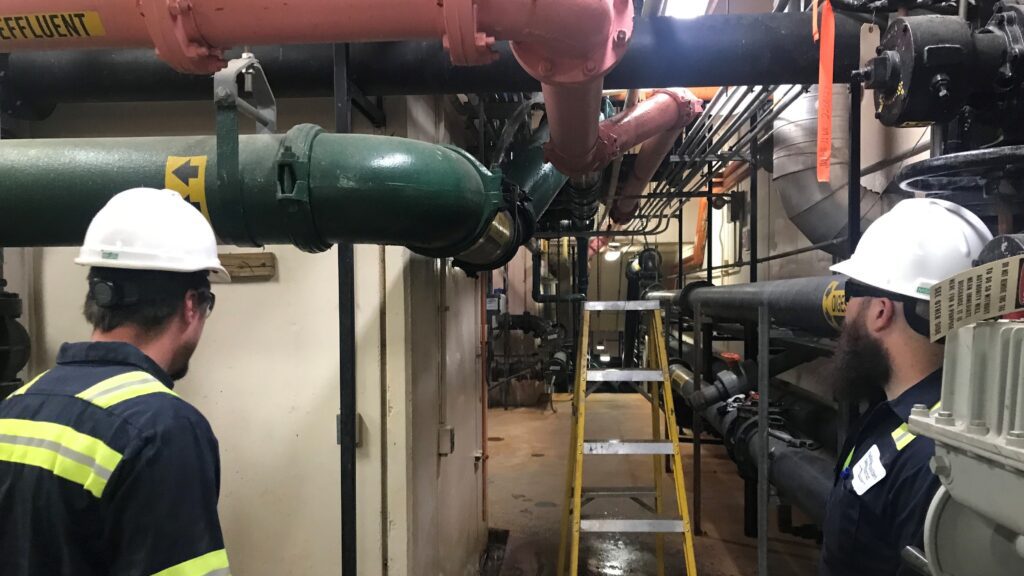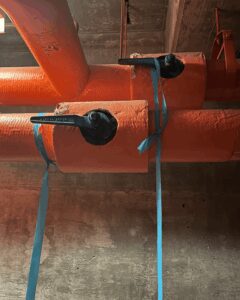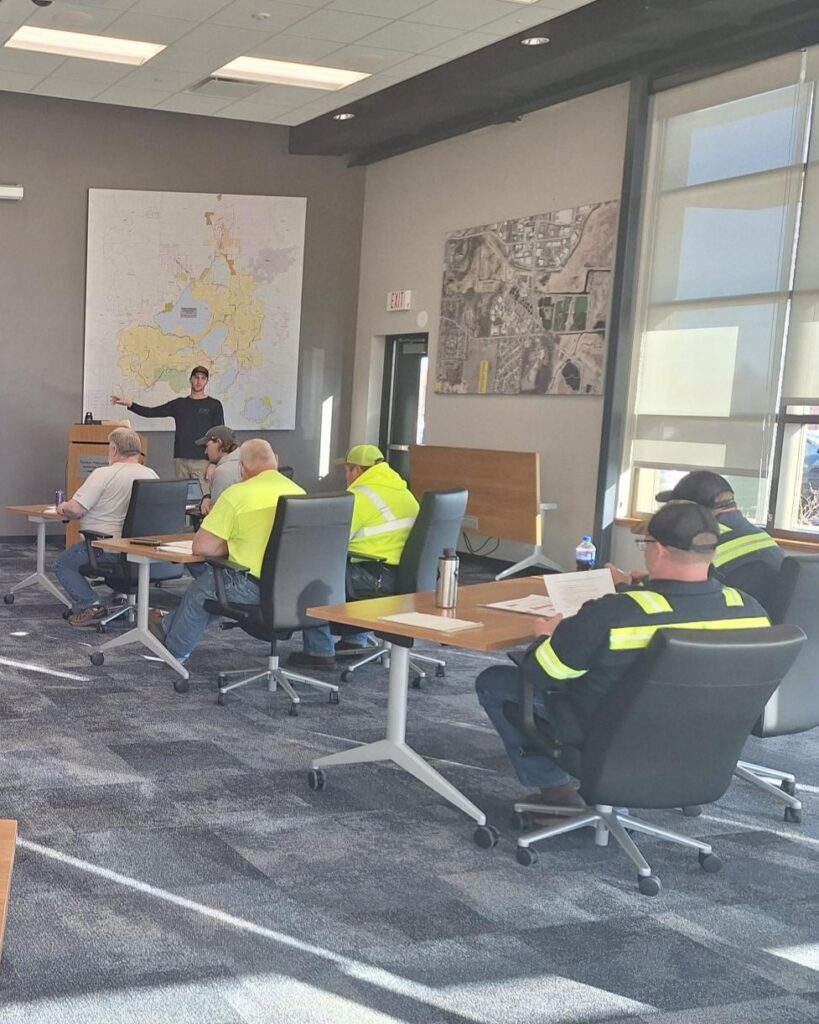When a piece of equipment at the plant needs repair or maintenance work, it often requires more than a simple flip of the switch to start the work. Those 37 million gallons of wastewater we treat each day don’t stop coming, so the effects of closing valves and rerouting flow have to be considered by a trained eye – in this case, the (many) expert eyes of the Operations team.

Operators, who monitor the functioning of the plant and operate its process equipment 24/7, use not only their eyes, but also their ears and noses. “All the senses are used,” says Nathaniel Heiden, operator supervisor. “If something is off, for operators, they say you smell it first, you hear it second and you see it third.”
In addition to continuously collecting information about the plant throughout their daily (and nightly) work, operators also have to do a lot of mental processing and analytical work. “They have to think ‘I know if I make a change it’s going to affect this upstream and this downstream,’ process that information and make reasonable choices,” says Nathaniel.
Planning for maintenance work on plant equipment calls on operators to use those analytical skills. Some jobs require Operations to plan a more complex shutdown, where flow is stopped or rerouted so maintenance technicians can safely access the equipment. And sometimes that can cause a ripple effect, where multiple processes in the plant will be impacted and multiple minds from both Operations and Maintenance need to come together to analyze and plan.

Knowledge capture: from talking to documenting
Historically, information about and coordination of larger-scale shutdowns was mostly communicated verbally, leveraging the longevity and experience of both Operations and Maintenance staff. Today, staff rosters are much greener. But this, and the addition of dedicated maintenance planners, creates the opportunity to establish new systems and efficiencies. Operator Jon Karch and (then) maintenance planner Matt Rodenkirch did just that and collaborated on a more formalized shutdown workflow to thoroughly plan and communicate about larger-impact, scheduled maintenance work at the plant.
Jon had been working on creating a standardized template for operators to use for shutdown plan packets for a few years, which included revamping a system to mark valves using ribbons to communicate information about the valve. These ribbons play a key role in shutdowns as a way to indicate which valves need to be closed so that equipment and lines are isolated and safe to perform work on.
From his perspective as a maintenance planner, Matt saw the need for increased communication between Operations and Maintenance, defining key roles in a shutdown plan, and establishing a consistent, shared location where shutdown plans are stored so they could be used as a reference by both Operations and Maintenance staff.
Effective plans start with clear steps
Jon and Matt both agree that the main goals of the workflow are safety, communication and having documented resources for current and future reference. “It’s a way to standardize information and spread it out to everyone involved,” says Jon, “and that way we have a record of what was done.”
The completed workflow defines what both Operations and planners/project managers (PMs) will provide in developing a shutdown plan; it also includes clear, sequential steps to follow and defines roles. One of the first steps is for a planner/PM to contact the operator supervisor, Nathaniel, and give him the project scope. Nathaniel then assigns an operator designee for the project, who will create the operational shutdown packet and work directly with the planner/PM.
“Because all these people are at the table early and you’re each able to offer up your interests and concerns, operations can help decide the best timing,” says Nathaniel. “While the process takes longer, it should have less of an impact on the operations of the plant.”
Walkdowns are essential for shutdownS
Another important step established by the workflow is for the planner/PM to schedule two final walkdowns of the affected equipment and area after the shutdown plan is created. The first is done by the maintenance and reliability manager, operator designee, planner/PM, and safety manager. “That way we have four sets of eyes from four different points of knowledge,” says Matt.
The second happens the day the work begins and is done by the maintenance technician on the job and the operator on duty. This final walkthrough is the most important from Jon’s and Matt’s perspectives. “Safety supersedes everything else,” says Matt. “The goal is for both the operator and the technician to be comfortable with the work commencing.”
This is when the shutdown packet is key too – it’s printed out and brought to the final walkthrough so that even if the operator briefed ahead of time on the shutdown is, say, out sick, another operator can step in for them. “The idea of the packet is that anyone else involved can look at it and have a good understanding of what’s going on and what’s going to be affected,” says Jon.

Jon created a safety sign-off sheet for the operator and technician to complete at the end of the final walkthrough to help signify each role’s responsibility. Nathaniel and Jon say this establishes the handoff of ownership of the equipment from operators to the maintenance technicians. “This way there is no question about the transition,” says Jon. “It makes sure everyone is on the same page with what’s going on.”
Launching and fine-tuning the workflow
In January, Matt held a training to roll out the shutdown workflow to all Operations and Maintenance staff involved in project planning and scheduling. Supervisors and PMs may also initiate the workflow in their planning, or a technician can decide to initiate one if they determine a job involves more complexity in safely isolating equipment than first thought.
The shutdown workflow is still early in its rollout phase, but it is working as designed. More operators are taking on the operator designee role and writing shutdown plans – having a template and other previous shutdown packets to reference makes that easier and more efficient. People are also finding ways to expand on the information captured in the plans; recently, a section was added to capture notes about bringing equipment back online and what didn’t go to plan.
What’s important to Jon, Matt and Nathaniel is that people use the workflow and communicate. “We’re still identifying improvements,” says Nathaniel. “We want to build it rigid enough so that it does what we want but flexible enough to adapt to people’s strengths and the means that people will use.”
By Jessica Spiegel
Read more about the work of our Operations team in the article “Night ops: Night shift operators are essential to plant’s success” or learn about how we treat wastewater via our virtual tour.






